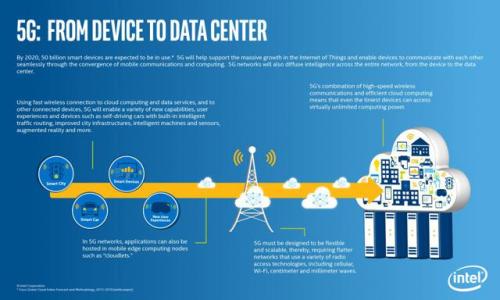要靠5G重回移动市场,英特尔都在做什么
英特尔在IDF 2015上谈到了对5G的一些看法,但这一讨论的重要性却被很多主流媒体忽略了,毋庸置疑,英特尔迫切期待5G时代的到来,5G可以让更多设备的联网成为可能。事实上,电信运营商已经在开始为5G做标准化的准备工作。英特尔透露出来的信息是他们已经开始了5G调制解调器的开发工作,也许可帮助其缩小与高通等移动芯片供应商的距离,以弥补在移动市场上的损失。
Summary
Intel went into the gory details when it came to 5G at IDF 2015. Unfortunately the discussion on 5G flew under the radar as various other developments were given higher importance in the mainstream media. Needless to say, the speeds Intel anticipates from 5G are very disruptive. 5G is a strategic enabler to more web-connected devices. Of course, Intel isn't speaking out into an empty vacuum. There's confirmation from telecoms that they're beginning to set the standards for 5G. This implies that Intel already is working on 5G capable modems, which may mean Intel could close the gap between Qualcomm and start shoring up mobile losses.The most important thing that came out of IDF 2015 was the keynote pertaining to 5G, which has disruptive implications for the Internet of Things and ties very closely to whether or not Intel can develop a meaningful amount of traction in the mobile space. For the most part, Qualcomm (NASDAQ:QCOM) has been able to maintain its shipment volume due in part to its comprehensive mobile package, which integrates all of the semiconductor components inside of a mobile device, aside from the memory and screen.
Hence, Intel (NASDAQ:INTC) hasn't been able to transition away from its contra revenue. But I do anticipate that losses pertaining to mobile will considerably decline over the next three fiscal years. The low pricing on app processors explains why Intel rebates below its bill of materials. It's not likely that Intel will ever price its mobile chips the same way it prices its desktop and laptop counterparts. Intel needs to scale the production of mobile chips otherwise there won't be any contribution to profits as the developments of mobile CPUs and baseband modems is R&D intensive.

Source: Intel
In Intel's presentation, the company believes that there will be 50 billion devices in use by 2020. While that's a very aggressive forecast, there's no denying the proliferation of various computing devices, which extends the growth potential beyond conventional desktop computers. Of course forecasts vary when it comes to long run semiconductor growth, as Taiwan Semiconductor Manufacturing (NYSE:TSM) recently mentioned on a recent quarterly earnings conference call that growth for the entire industry is expected to range between 4% to 6%. Foundries are expected to grow slightly quicker as they're directly linked to the growth in areas not pertaining to PCs and smartphones.
That being the case the performance aspect is what's really interesting here. At least according to EE Times, the Intel panel anticipates a monumental improvement in speed:
The panel made it clear that their major metric was speed - which they predicted would be 100-to-1000 times faster with sub-millisecond latency, enabling the kind of real time interactivity - such as virtual worlds - which today only exist in science fiction books like William Gibson's Neuromancer which virtually defined the concept of cyberspace as a world on a level-playing-field with nature.
This implies that Qualcomm's upcoming Gobi modems are nowhere near the speeds of 5G. Investors can anticipate uplink and downlink speeds that are substant
5G 移动市场 英特尔 Qualcomm CPU 相关文章:
- 2.5G手机芯片战火起大陆市场陷红海(11-25)
- 芯片巨头5G战预热中 中国成立研究组(06-17)
- 罗姆新推背光灯用白色LED驱动IC,可自动调节亮度(09-12)
- 小型、高效、大功率兼备的升压型DC/DC转换器“BD1865GWL”(03-07)
- ROHM开发出高效电源管理IC BD71815GW(05-03)
- 全新Littelfuse LSP05GI系列热保护SPD 10kV_5kA浪涌保护模块(09-14)
